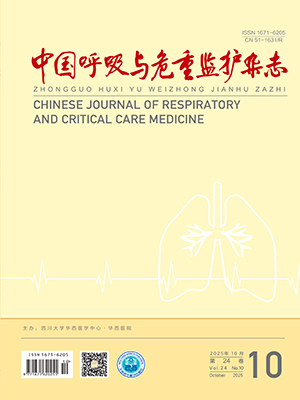Objective To explore the effect of budesonide nebulization in the treatment of mechanically ventilated patients with chronic obstructive pulmonary disease(COPD).Methods A total of 25 intubated and ventilated COPD patients complicated with respiratory failure was randomly divided into two groups.The control group consisted of 12 patients received salbutamol nebulization on the routine treatment.The budesonide group consisted of 13 patients received budesonide plus salbutamol nebulization on the routine treatment.Variables such as tumor necrosis factor-α(TNF-α) and interleukin-8(IL-8) in the bronchoalveolar lavage fluid(BALF) , incidence of ventilation-associated lung injury(VALI) , days of mechanical ventilation ,, days of hospitalization and survival rate were measured and compared.Results The survival rate and incidence of VALI were not different significantly between the two groups.However , the levels of TNF-α and IL-8 in BALF of the control patients were significantly lower than those in the budesonide group[ ( 1.2±0.2 ) mg/L vs ( 1.5±0.4 ) mg/L ,( 85.7±26.5 )( 125.6±30.4 ), both P lt;0.05).And the days of mechanical ventilation and hospitalization were statistically shorter in the budesonide group compared with the control group[ (7.2±2.5 ) d vs ( 10.5±6.2 ) d , (10.5±4.7 ) d vs (15.8±6.6 ) d , both P lt;0.05].Conclusion Our data suggest that nebulization of budesonide can suppressed the pulmonary inflammation and decreased days of the mechanical ventilation and hospitalization in mechanically ventilated COPD patients.
Citation: CUI Zhaobo,GAO Xiuling,LIU Shuhong,LI Suyin,ZHANG Juxiang. Effects of the budesonide nebulization in the treatment of mechanically ventilated patients with chronic obstructive pulmonary disease. Chinese Journal of Respiratory and Critical Care Medicine, 2008, 08(4): 268-270. doi: Copy
Copyright © the editorial department of Chinese Journal of Respiratory and Critical Care Medicine of West China Medical Publisher. All rights reserved




